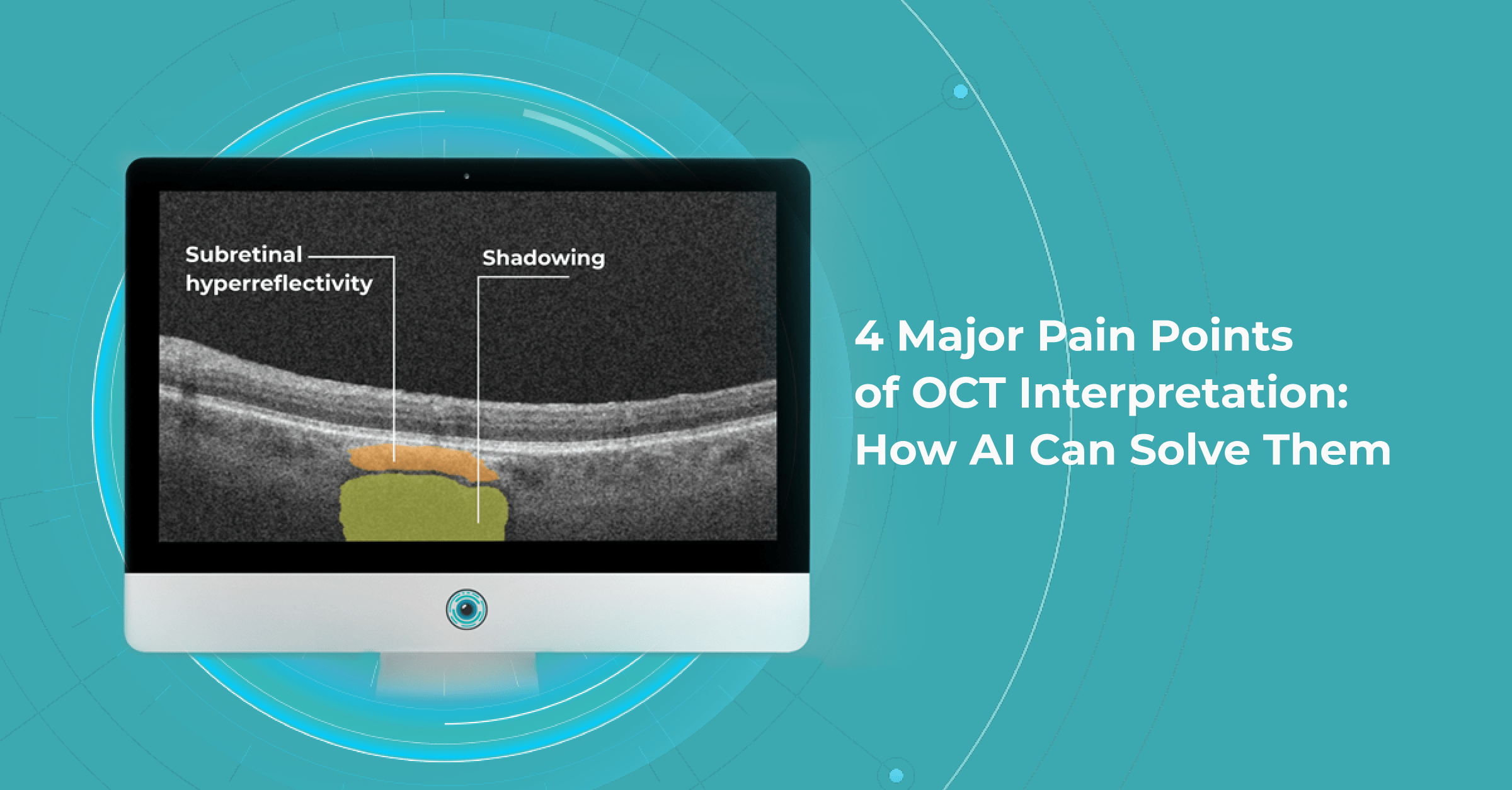
Maria Znamenska
Associate Professor of Ophthalmology, Retina Imaging Expert
Chief Medical Officer at Altris AI
Reading time
5 min. read
OCT Interpretation & Eye Examination: How AI can Solve 4 main Problems
The data derived from OCT interpretation provides us with an unthinkable amount of knowledge compared to just a few decades ago. However, the downside of this advancement is that the expertise needed to interpret the scan has also grown exponentially.
Also, with such a machine’s precision, even the slightest changes in the needed conditions can compromise the scan’s reliability. For instance, the patient’s head tilt can affect the measured thickness of the retinal nerve fiber layer. Therefore, differentiating between normal and pathological findings is crucial for accurate diagnosis and effective patient management.

Steps in OCT interpretation
When evaluating an OCT scan, the most logical first step is to compare it to the appearance of a healthy macula. Retinal anatomy can be challenging, but simply put, you can divide the retina into two zones: the inner and the outer retina.
The top portion of a B-scan represents the inner retina, which lies closest to the vitreous humor. The inner retina comprises layers from the internal limiting membrane to the external limiting membrane (ILM, RNFL, GCL, IPL, INL, OPL, ONL, ELM). The central retinal artery supplies blood to the inner retina; its largest capillaries are located innermost, while the smallest capillaries are outermost at the level of the INL and IPL.
The outer retina is closest to the choroid (bottom of the B-scan). It consists of the photoreceptor layers through to the choroid (PR, RPE, Bruch’s membrane, choriocapillaris, and choroidal stroma). The outer retina is avascular, receiving its oxygen and nutrients from the choroid.
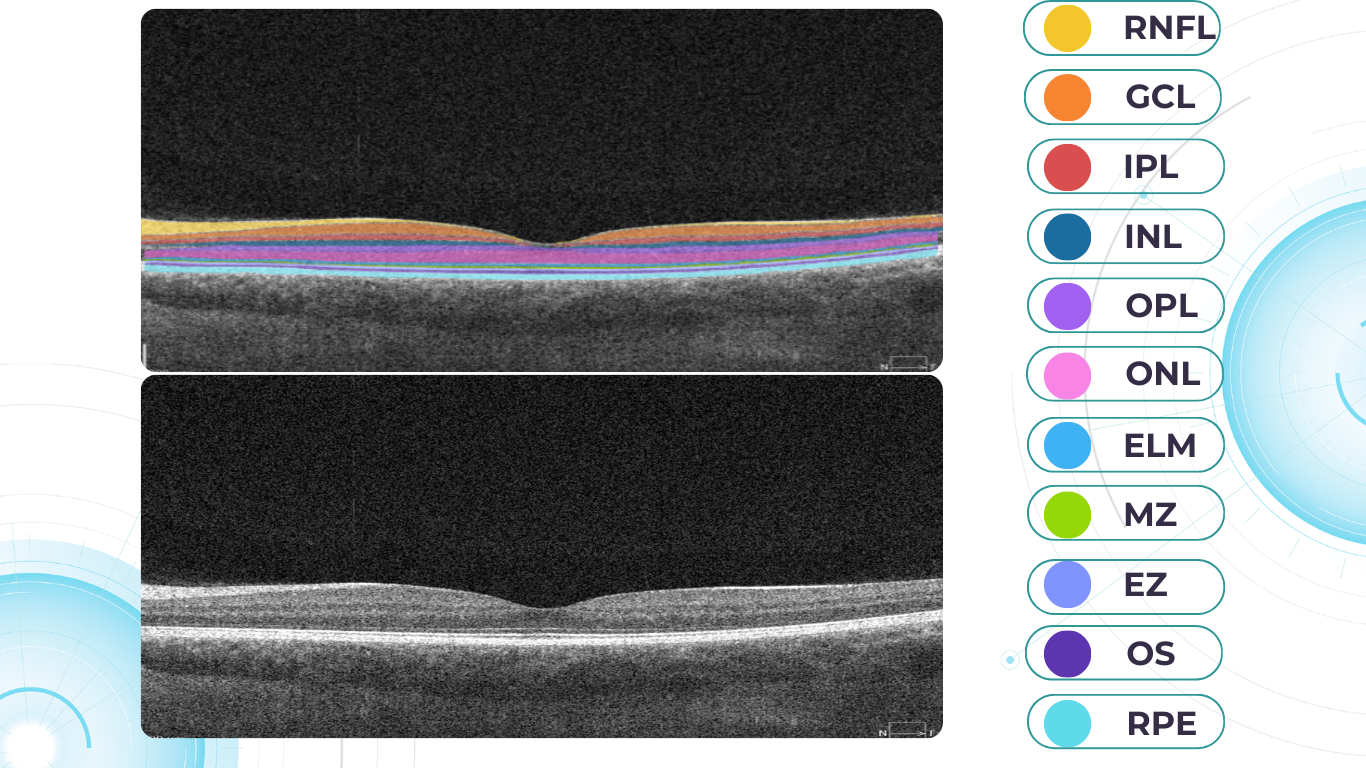
The next step in evaluating a scan is determining whether the correct retinal layers are hyperreflective (dark) and hyperreflective (bright).
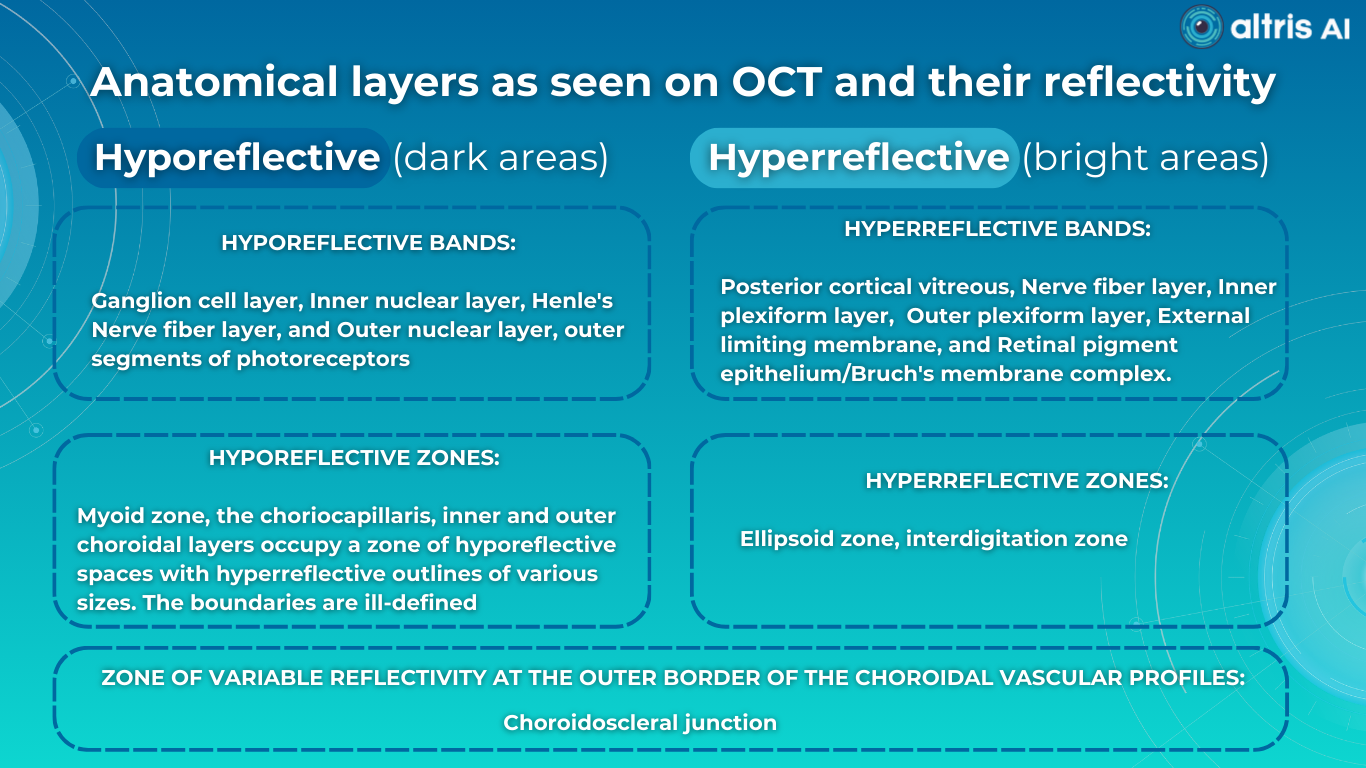
Identifying the specific layer in which a change is observed on the OCT scan will not only provide clues to possible pathologies but also help discern the underlying process. For instance, changes in the Retinal Pigment Epithelium (RPE) may affect metabolic support and the health of photoreceptor cells, while thinning of the nerve fiber layer can indicate degenerative processes, such as glaucoma. OCT findings also provide insights into a patient’s visual acuity.
Another crucial aspect of OCT interpretation is assessing the integrity of the retinal structure. In diseased eyes, you frequently encounter disruptions of the RPE or the ellipsoid zone (EZ). These disruptions often result from fluid accumulation that elevates higher layers from beneath.
OCT also allows visualization of any breaks in the retina. These breaks, commonly referred to as retinal tears or holes, can be classified as full-thickness or partial-thickness, depending on their extent.
Blurring or loss of definition of retinal structures is another key finding in OCT interpretation. This signifies a loss of the retina’s normal layered organization. One example is the disorganization of inner retinal layers that can occur in age-related macular degeneration (AMD), manifesting as indistinct layers merging into a homogenous mass.
As you can see, although OCT is widely regarded as a superior imaging modality, it remains a complex instrument that can lead to misdiagnosis, especially for those early in their careers.
For this article, we surveyed eye care practitioners to understand how they learned the interpretation of OCT, how often they encounter challenging or controversial scans in their practice, and what major pain points could be addressed with AI-assisted OCT interpretation.
According to our survey, there are four main ways to get OCT education: webinars, conferences, atlases, and mobile apps.
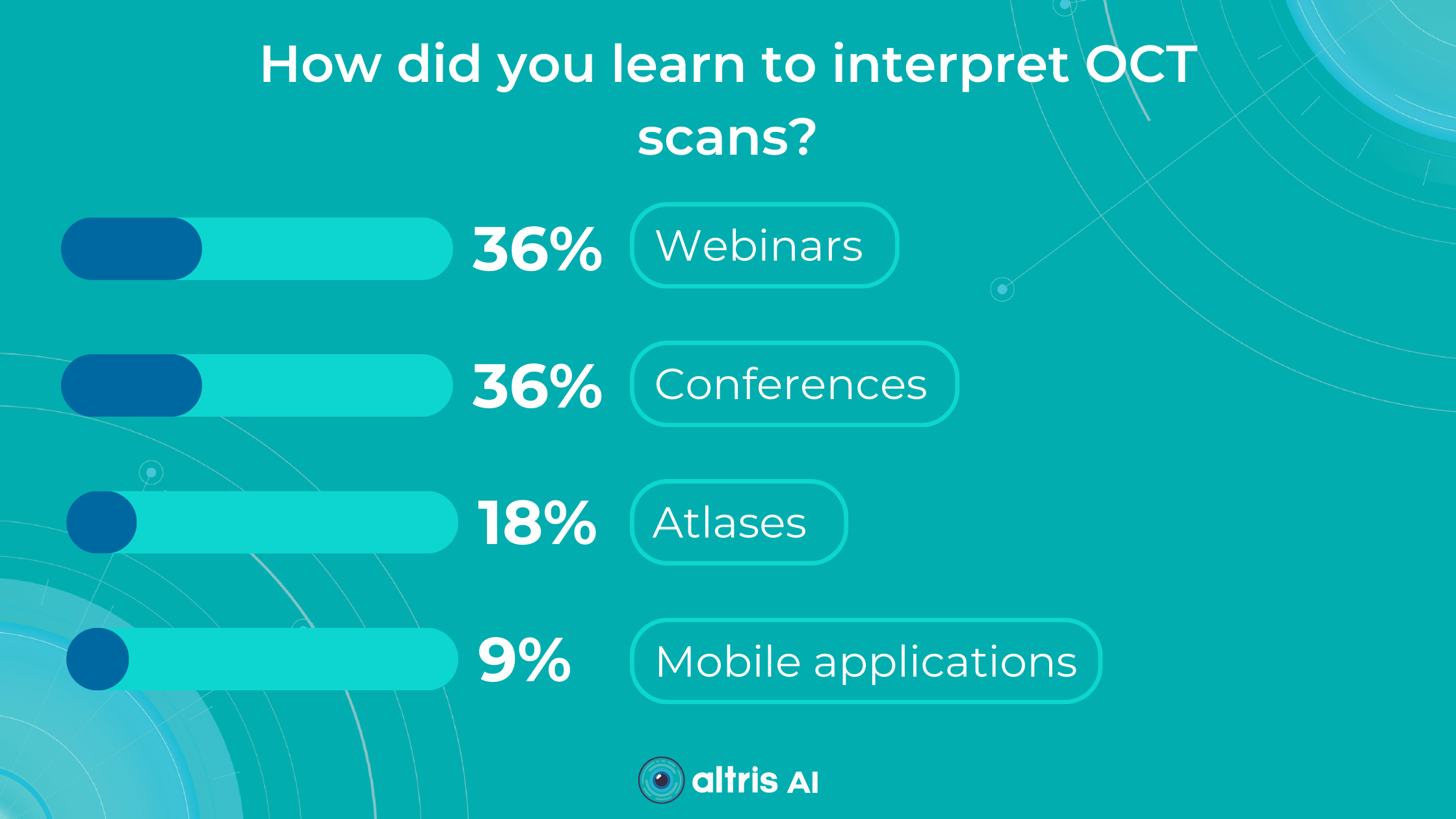
But even after attending courses or webinars, ophthalmologists and optometrists often feel that while they possess theoretical knowledge, they lack the practical experience necessary to feel fully confident in interpreting real-world OCT eye examinations. Thus, they may avoid working with OCT, even though they know its revolutionary value.
By surveying 1034 seasoned and newly practicing optometrists and ophthalmologists worldwide, encompassing a broad spectrum of clinical experience, we’ve identified the four main barriers to embracing OCT technology.
Four pain points of OCT interpretation
-
Lack of confidence
Our survey revealed that 16.3% of eye care specialists avoid offering OCT eye examinations to their patients due to a lack of confidence in their interpretation skills. This mirrors a similar situation where even experienced practitioners may over-refer patients to eye hospitals out of an abundance of caution. While this approach might be justifiable in individual cases, it ultimately proves detrimental in the long run. For practitioners, it leads to a decline in clientele, while patients suffer from not receiving timely care at their initial point of contact.
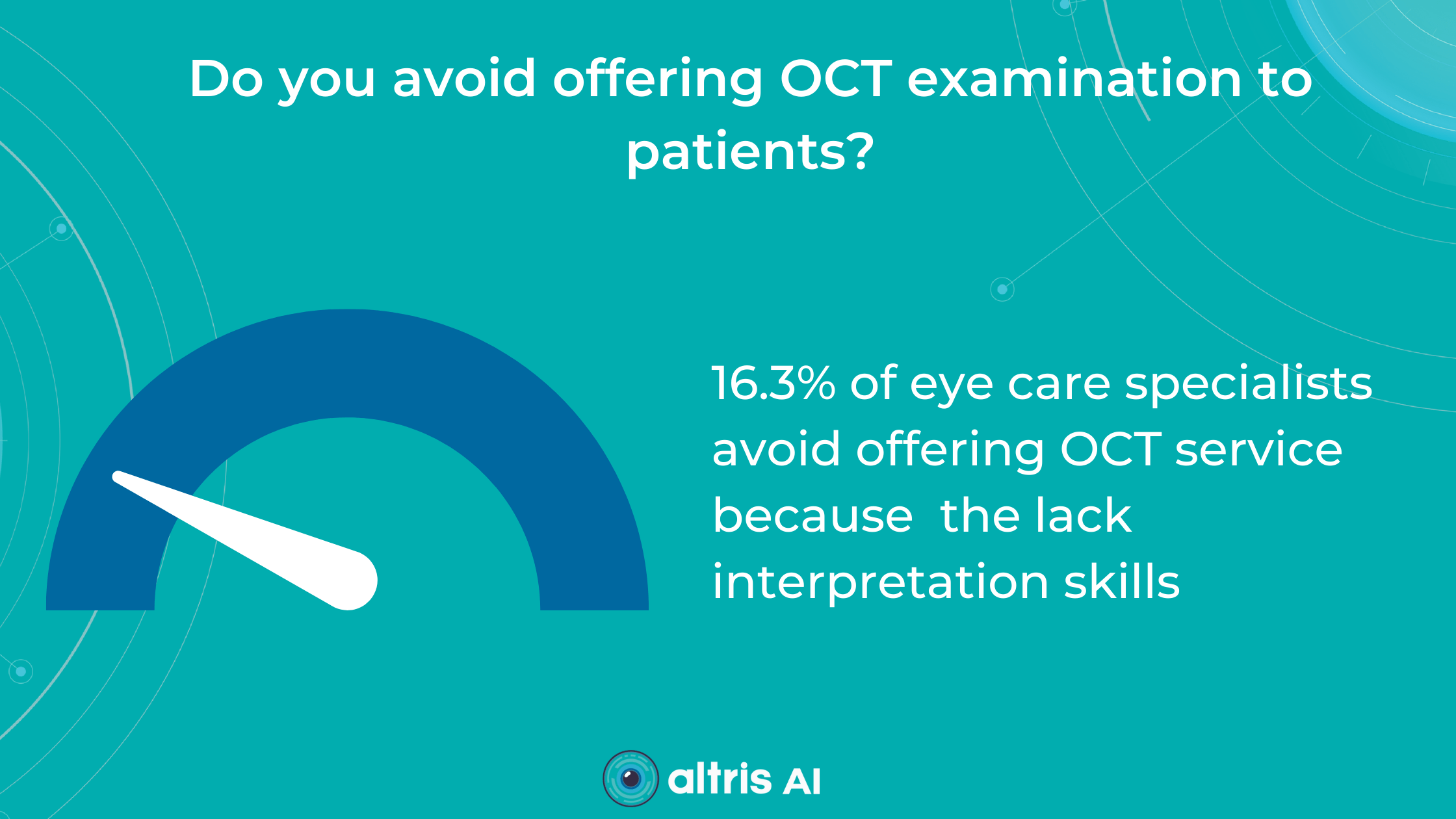
-
Slow OCT scan reading
While a machine can capture thousands of high-resolution scans in mere seconds, a clinician’s subsequent OCT interpretation is far more time-consuming. They must meticulously analyze each scan, not only for any signs of pathology but also in the context of the patient’s complete medical history.
Some eye care specialists may spend up to 40 minutes per OCT examination, which can negatively impact their practice’s efficiency and overall quality. However, on average, specialists dedicate about 10 minutes per OCT eye exam, assuming they are satisfied with the report generated by their device’s OCT interpretation and are not faced with ambiguous or difficult-to-interpret scans.
-
Minor, early, rare pathologies missed
Another common challenge in OCT scan interpretation is the potential for overlooking minor, early, or rare pathologies. Our survey reveals that 20.2% of eye care specialists miss such findings 1-3 times per week, while 4.4% miss them more frequently, 3-5 times a week. However, these figures only represent acknowledged errors. A concerning 30.5% of ophthalmologists and optometrists admit they are unsure whether they miss any minor, early, or rare pathologies.
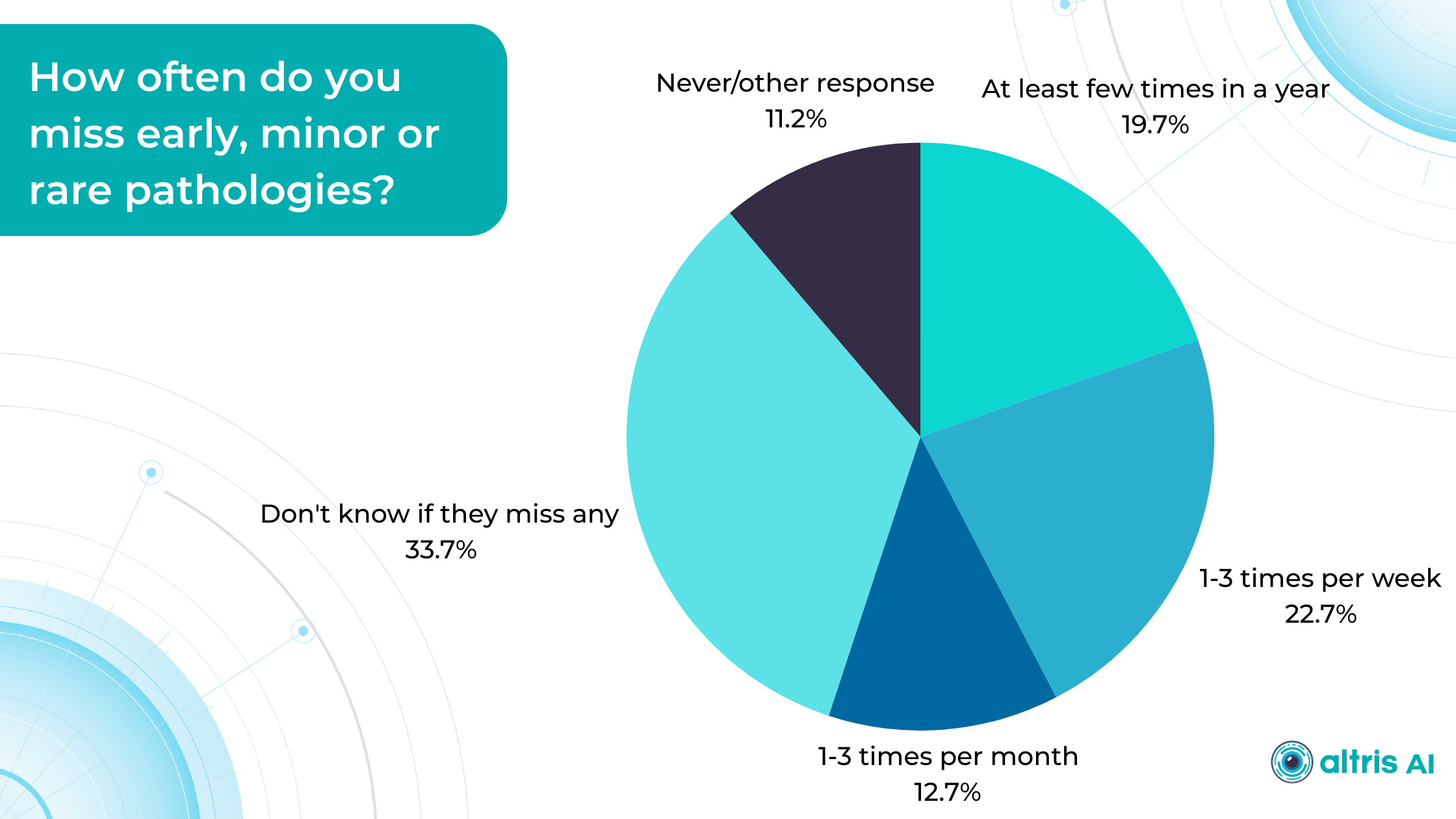
Failing to identify pathologies in their early stages can have devastating consequences for patients. For example, missing early signs of glaucoma, an irreversible condition, can lead to blindness. Similarly, overlooking rare or minor pathologies can result in inadequate patient follow-up and treatment, potentially exacerbating the condition. Accurate OCT interpretation and timely diagnosis are paramount for positive patient outcomes. This discussion focuses solely on the devastating impact on patients’ lives and doesn’t even delve into the potential legal ramifications of missed signs on OCT scans.
-
Controversial Scans
Most eye care specialists encounter challenging or ambiguous OCT scans that they find difficult to interpret in their practice. In the vast majority of cases (99%, to be precise), eye care specialists seek a second opinion from their colleagues when faced with an uncertain scan.
However, not all clinicians have equal access to this valuable resource. Optometrists and ophthalmologists (practicing in remote or rural areas) often work in isolation, lacking the readily available professional support network that their colleagues in hospital settings enjoy. While those in hospitals can quickly consult peers for additional insights or guidance, the mentioned group often faces limited opportunities for collaborative decision-making and professional development.
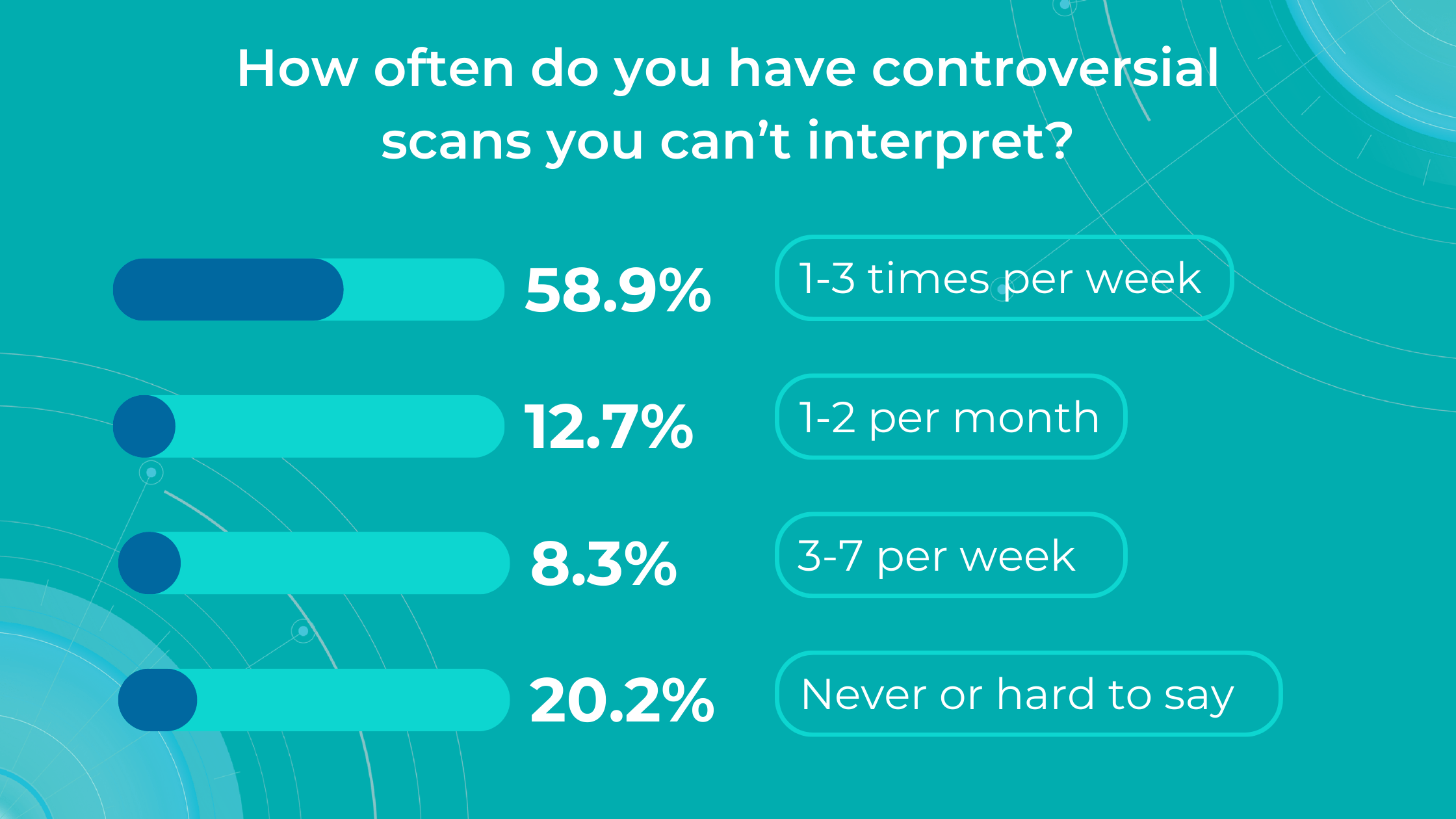
In many professions, sharing challenging information with colleagues online could easily overcome these obstacles. However, the highly sensitive nature of medical data prevents eye care professionals from utilizing such convenient solutions.
How AI can help with OCT interpretation
-
Workflow optimization
Our recent survey showed that among more than 1000 participating eye care specialists, 40% have more than 10 OCT exams daily. Meanwhile, 35% of eye care specialists have 5-10 OCT daily examinations. Unfortunately, more patients per day mean an increased risk that specialists may miss some minor, rare, or early conditions.
Artificial intelligence can significantly speed up the screening process and OCT interpretation while reducing the controversy around diagnoses. This faster and more accurate diagnostic tool will enable more patients to be seen, allow for quicker responses to pathologies that pose a risk to eyesight, and reduce the burden on strained hospitals with needless patient referrals, as well as free up patients from unnecessary stress and wasted time.
For instance, the Altris AI platform, which offers AI-powered interpretation of OCT for 70+ pathologies, has a severity grading of b-scans. Severity grading means it is easy to see if the eye is healthy (removing any need to spend time interpreting) or highlight where the pathology is and the degree of severity.
- Green – no pathology detected
- Yellow – mild to medium level of severity
- Red – severe pathology detected
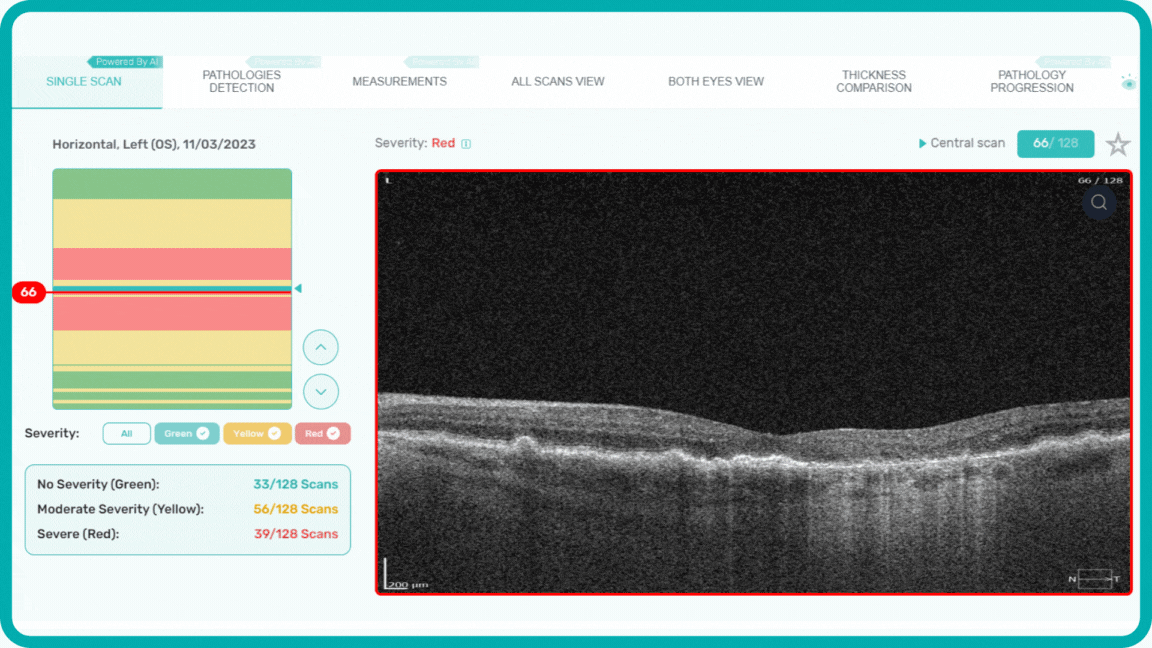
Artificial intelligence tools also offer an interpretation of OCT in reports with customized measurements and selected biomarkers, retinal layers, or segments, allowing precise focus on treatment monitoring and patient response to therapy. This fastens the exam procedure and provides patients with educational materials they can understand.
Customizable and enriched OCT reports also enhance a patient’s medical history: the streamlined process of integrating OCT data into EMR ensures that every eye scan, with its corresponding measurements, biomarkers, and visualizations, becomes an easily accessible part of the patient’s medical history.
This is crucial for continuity of care and simplifies the audit process, providing a clear and comprehensive record of the patient’s eye health over time. Just optometry chains alone can perform an imposing volume of OCT scans, with some reaching upwards of 40,000 per week. While this demonstrates the widespread adoption of this valuable diagnostic tool, it also presents a challenge: the increased risk of missing subtle or early-stage pathologies amidst the sheer volume of data.
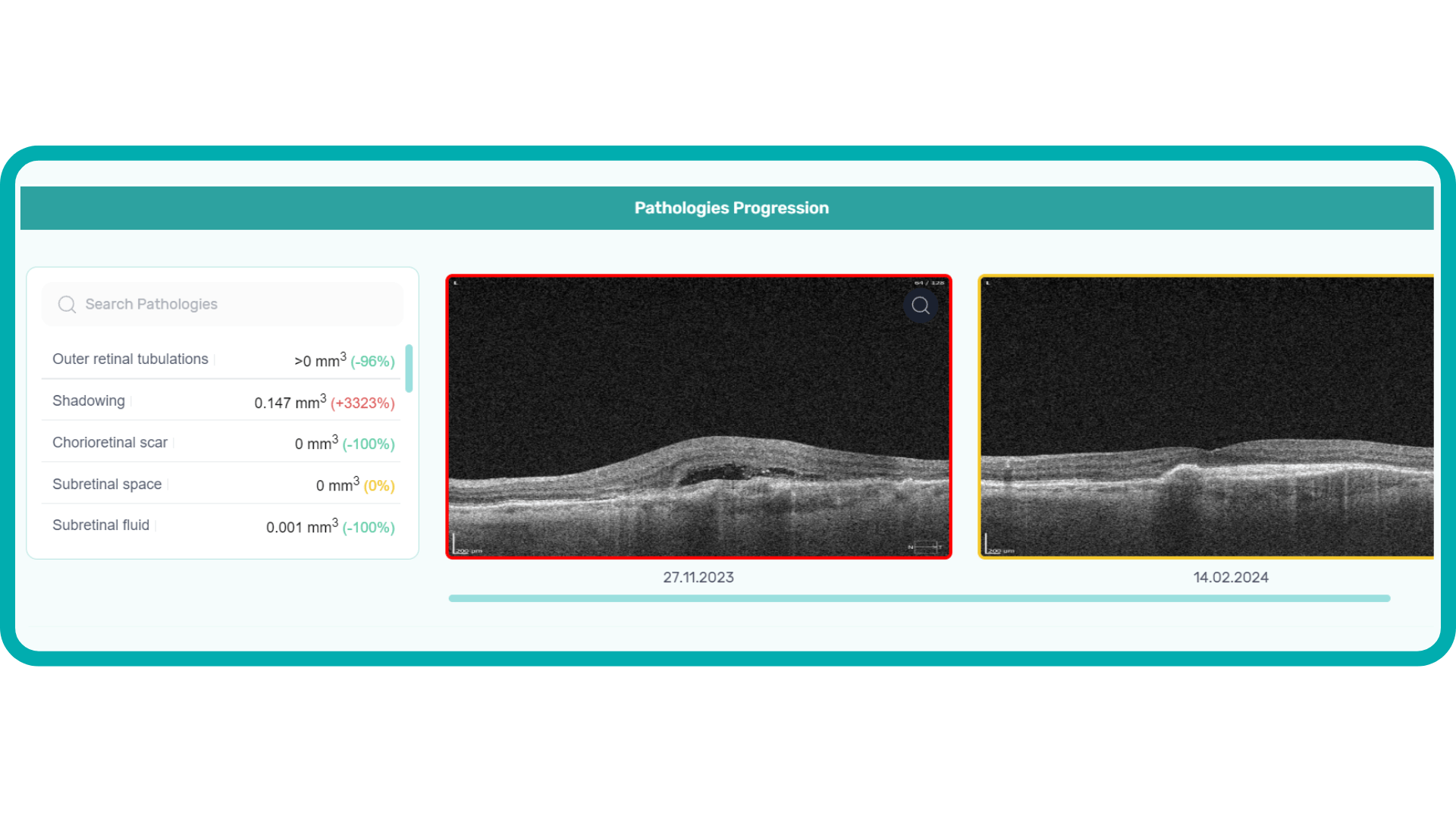
Enhanced OCT reports offer a solution by providing a crucial “second look” at scan results. While not foolproof, this double-check significantly reduces the risk of overlooking abnormalities in OCT interpretation, ultimately improving patient outcomes and safeguarding the clinic’s reputation.
-
Identification of minor, early, and rare pathologies, including Glaucoma
AI systems that include pathology detection and segmentation in OCT scan interpretation enable automated disease characterization and longitudinal monitoring of therapeutic response. Wet AMD, Diabetic Retinopathy, and genetic diseases are among the pathologies that lead to blindness if not detected in time. Detecting pathological signs and pathologies related to these disorders in time can literally save patients from future blindness.
Another significant benefit of machine learned systems with early detection is OCT analysis for early glaucoma. Current tests often rely on observing changes over time, delaying treatment assessment and hindering early identification of rapid disease progression. OCT frequently detects microscopic damage to ganglion cells and thinning across these layers before changes are noticeable through other tests.
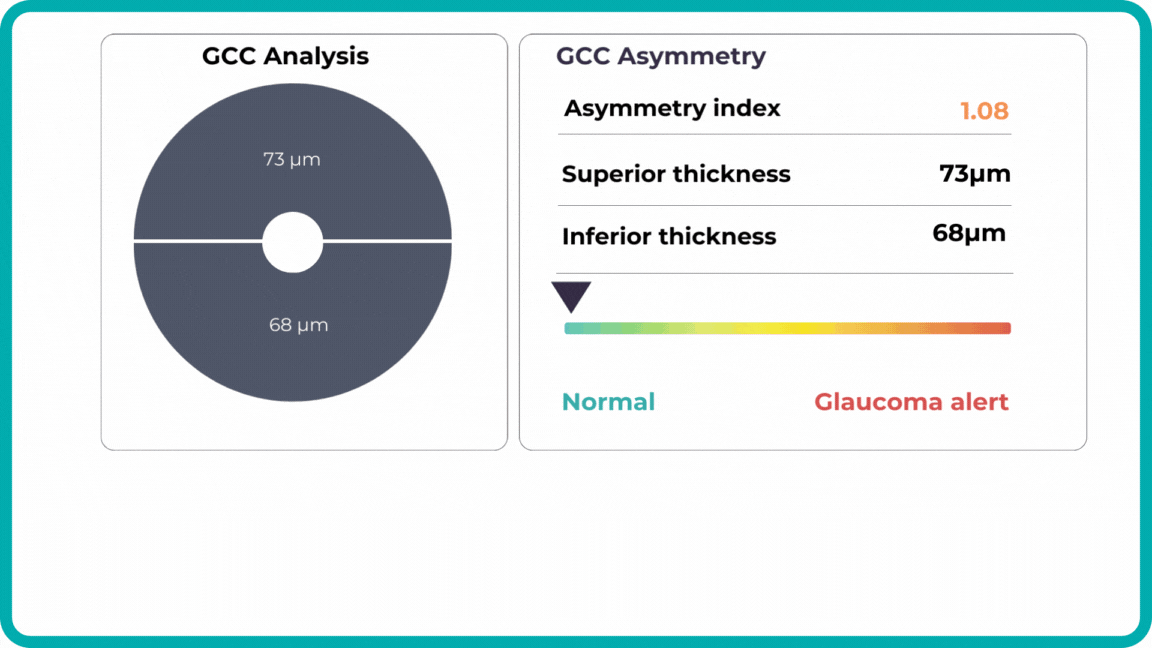
Another benefit of AI systems is that OCT interpretation for glaucoma usually utilizes a normative database to assess retinal normality. However, these databases are limited and represent an average of a select group of people, potentially missing early glaucoma development in those who deviate from the “norm.” Conversely, individuals may be unnecessarily referred for treatment due to not fitting the “normal” profile, even if their eyes are healthy.
-
Second opinion
With AI-assisted OCT, you have the combined knowledge and experience of leading eye care specialists for every patient. This technology leverages massive datasets of medical images and clinical data meticulously analyzed by retinal experts during AI development. It is a valuable second opinion tool, helping you confirm diagnoses and identify subtle patterns the human eye might miss.
For example, the Altris AI mentioned above leverages a massive dataset of thousands of OCT scans collected from 11 ophthalmic clinics over the years. Carefully segmented and labeled by retinal professionals, these scans were used to train the AI. By analyzing each pixel of an image and its position relative to others, the AI algorithms have learned to distinguish between different biomarkers and pathologies.

Summing up
While OCT has revolutionized eye care diagnostics, its full potential is hindered by challenges in interpretation, ranging from a lack of confidence to time constraints, the risk of missing subtle pathologies, and fear of malpractice. The survey of eye care professionals underscores a critical need for innovative solutions, particularly for practitioners who lack access to immediate peer consultation. These pain points highlight the potential for AI-assisted OCT interpretation to not only streamline workflows but also significantly enhance diagnostic accuracy and patient care.
